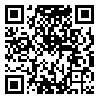Volume 4, Issue 1 (january 2020)
AOH 2020, 4(1): 480-484 |
Back to browse issues page
Download citation:
BibTeX | RIS | EndNote | Medlars | ProCite | Reference Manager | RefWorks
Send citation to:



BibTeX | RIS | EndNote | Medlars | ProCite | Reference Manager | RefWorks
Send citation to:
Fouladi Dehaghi B, Deris J, Mosavi Qahfarokhi M, Golbaghi A, Nematpour L. Evaluation of Ionizing Radiation in Five Private Radiology Centers in Khuzestan. AOH 2020; 4 (1) :480-484
URL: http://aoh.ssu.ac.ir/article-1-140-en.html
URL: http://aoh.ssu.ac.ir/article-1-140-en.html
Behzad Fouladi Dehaghi1 

 , Jamileh Deris *2
, Jamileh Deris *2 

 , Maryam Mosavi Qahfarokhi3
, Maryam Mosavi Qahfarokhi3 

 , Ameneh Golbaghi3
, Ameneh Golbaghi3 

 , Leila Nematpour3
, Leila Nematpour3 




 , Jamileh Deris *2
, Jamileh Deris *2 

 , Maryam Mosavi Qahfarokhi3
, Maryam Mosavi Qahfarokhi3 

 , Ameneh Golbaghi3
, Ameneh Golbaghi3 

 , Leila Nematpour3
, Leila Nematpour3 


1- Associate Professor, Department of Occupational Health, Health Faculty, Ahvaz Jundishapur University of Medical Sciences, Ahvaz, Iran
2- Abadan Faculty of Medical Sciences, Abadan, IranAbadan Faculty of Medical Sciences, Abadan, Iran ,deris.j.1389@gmail.com
3- Department of Occupational Health, Health Faculty, Ahvaz Jundishapur University of Medical Sciences, Ahvaz, Iran
2- Abadan Faculty of Medical Sciences, Abadan, IranAbadan Faculty of Medical Sciences, Abadan, Iran ,
3- Department of Occupational Health, Health Faculty, Ahvaz Jundishapur University of Medical Sciences, Ahvaz, Iran
Abstract: (1866 Views)
Background: Nowadays ionizing radiation is widely used in medicine, research and industry. In medicine, ionizing radiation is used to diagnose diseases and in high doses to treat diseases such as cancer. Undoubtedly, most exposure to artificial sources is in the field of medical and diagnostic radiology. Therefore, practitioners in the field of diagnostic radiography and patients are exposed to ionizing radiation and its risks. On the other hand, despite the advantages and efficacy of diagnostic radiation in the medical field, overall less attention is paid to optimizing and controlling protection in medical radiation. Therefore, the aim of this study was to evaluate the background ionizing radiation in Ahwaz diagnostic radiography centers. Methods: Ionization radiation levels were measured in and out of each center using gamma spectroscopy (Radiation Alert Inspector-EXP 15109) at a, b, c, d and e radiographic centers within one meter above the Earth's surface. Radiation levels within each center were measured at four locations (outside of center, secretary desk, and patient waiting room and behind the radiology room) both in X-ray machine operating and non-operating condition. The obtained data were analyzed by SPSS software. Results: The inside ionization radiation dose in a, b, c, d and e radiographic centers were 0.121, 0.119, 0.126, 0132 and 0.128 μSv/h respectively. The outside ionization radiation dose in a, b, c, d and e radiographic centers were 0.094, 0.092, 0.093, 0.112 and 0.101 μSv/h respectively. Equivalent annual dose within and outside selected radiology centers were lower than the threshold (1 mSv / year). Conclusion: The results show that the ionizing radiation dose of the X-ray equipment examined in the radiology centers of Ahwaz is lower than the global standard.
Keywords: Ionizing radiation, Radiography, Equivalent dose, Equivalent annual dose, Employment factor.
Send email to the article author
| Rights and permissions | |
 |
This work is licensed under a Creative Commons Attribution-NonCommercial 4.0 International License. |




